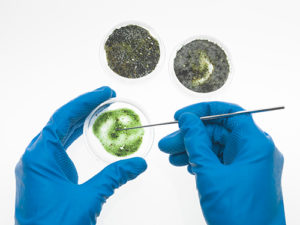Mold’s biggest weakness? Moving air. Mold thrives on moisture and stagnant conditions, but airflow is its natural enemy. By keeping air circulating in your home, you can prevent mold from taking hold. In this article, we’ll explore effective ways to keep mold at bay using smart airflow techniques.

Why Mold Needs Moisture to Grow
Mold requires two key ingredients to survive: moisture and a food source. Without these, mold cannot grow or spread. This is why drying damp surfaces and maintaining proper airflow are essential in keeping mold under control. Let’s look at some simple ways to use airflow to your advantage.
Curios if you might have mold in your home?
Take this quiz and we'll ask you the right questions so you'll know if you need to reach out to a professional.
🔗 Take the quiz now
Set Your HVAC to “Run” Mode, Not “Auto”
Your HVAC system is one of the most effective tools for keeping mold at bay. When set to “Auto,” the system cycles on and off based on temperature needs, leaving periods of stagnant air. Switching to “Run” mode ensures continuous airflow throughout your home, reducing moisture buildup and preventing the conditions mold needs to thrive.
Upgrade to a High-Quality Filter
Using a MERV 7 filter with anti-microbial agents enhances your system’s efficiency. These filters capture mold spores, allergens, and bacteria before they can circulate. Without proper filtration, airborne particles can compromise indoor air quality, forcing your body—especially your lungs—to act as the filter. Remember to replace filters every 1-3 months for optimal performance.
Use an Air Purification System
Air purifiers are an excellent investment for reducing mold risks and improving indoor air quality. High-efficiency systems, such as the BLS12K, are capable of capturing mold spores, dust, and other particles as small as 0.3 microns. Many purifiers also feature UV-C light technology to neutralize mold spores and bacteria.
Placement and Maintenance Tips
- Choose the Right Size: Ensure the purifier matches the square footage of your space.
- Optimal Placement: Use purifiers in mold-prone areas like basements or poorly ventilated rooms.
- Regular Maintenance: Clean and replace filters as recommended to maintain efficiency.
Keep Closet Doors Open or Vented
Closets are often neglected as potential mold hotspots, but their enclosed nature makes them susceptible to trapped humidity. Simple changes can make a big difference.
Ventilation Tips
- Leave Doors Slightly Open: This allows air circulation, reducing moisture buildup.
- Install Vented Doors: Louvered doors provide continuous airflow, even when closed.
- Use Dehumidifiers if Necessary: For especially humid climates, a small closet dehumidifier can help control moisture levels.
Additionally, store clothing and shoes in breathable containers instead of sealed plastic bins, which can trap humidity and encourage mold growth.
Use Exhaust Fans and Vent-a-Hoods
High-moisture activities like cooking and showering release significant amounts of water vapor into the air. Exhaust fans and vent-a-hoods help expel this moisture, making them essential for mold prevention in kitchens and bathrooms.
Best Practices for Exhaust Fans
- Run Fans Long Enough: After showering or cooking, leave fans running for at least 15-20 minutes to fully remove moisture.
- Clean and Maintain Regularly: Dust and grease buildup can reduce fan efficiency, so clean grilles and filters often.
- Ensure Proper Venting: Confirm that fans vent to the exterior of your home, not into attics or crawlspaces, where they could create new mold issues.
Don’t Forget the Ceiling Fans
Ceiling fans are a simple yet powerful tool for improving airflow in your home. They help break up stagnant air pockets, keeping rooms dry and mold-resistant.
Seasonal Usage Tips
- Summer: Set fans to rotate counterclockwise to push cool air downward.
- Winter: Reverse the direction to distribute warm air without creating drafts.
Regularly dust fan blades to prevent mold spores and allergens from accumulating, and consider pairing ceiling fans with dehumidifiers for maximum moisture control.
Frequently Asked Questions About Preventing Mold
Does UV Light Kill Mold?
Yes, UV-C light is effective in neutralizing mold spores by damaging their DNA, which prevents reproduction. It works best when integrated into HVAC systems or air purifiers, where it can treat circulating air. However, UV light is not a standalone solution for visible mold, which requires direct cleaning.
What Is the Best Cleaner for Mold?
- Hard Surfaces: Use a bleach solution (1 part bleach to 10 parts water) for non-porous materials like tile and glass.
- Porous Surfaces: Opt for vinegar or hydrogen peroxide, which penetrate deeper and are safer for materials like wood and fabric.
By combining these strategies with proper ventilation and moisture control, you can create an environment where mold struggles to survive, keeping your home healthier and safer.